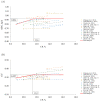Advances, Implications, and Limitations of Low-Crude-Protein Diets in Pig Production
- PMID: 36552397
- PMCID: PMC9774321
- DOI: 10.3390/ani12243478
Advances, Implications, and Limitations of Low-Crude-Protein Diets in Pig Production
Abstract
Currently, five crystalline essential amino acids (Lys, Met, Thr, Trp, and Val) are generally used, allowing formulation of low-crude-protein (CP) diets. Moreover, Ile may also be used depending on its economic value and the specific feeding program. Experimentally, it has been shown that further reduced CP levels can be achieved by supplemental His, Leu, and Phe to the diets. However, decreasing the dietary CP level while maintaining optimal ratios of amino acids has shown contradictory effects on pigs' growth performance. Due to the divergence in the literature and the importance for practical formulation strategies in the swine industry, a literature review and a meta-analysis were performed to estimate the minimum CP level that would not compromise pig performance. Based on the present review, there is a minimum CP level after which the growth performance of pigs can be compromised, even though diets are balanced for essential amino acids. Considering average daily gain and gain to feed, respectively, these levels were estimated to be 18.4% CP (95% confidence interval [CI]: 16.3 to 18.4) and 18.3% CP (95% CI: 17.4 to 19.2) for nursery, 16.1% CP (95% CI: 16.0 to 16.2) and 16.3% CP (95% CI: 14.5 to 18.0) for growing, and 11.6% CP (95% CI: 10.8 to 12.3) and 11.4% CP (95% CI: 10.3 to 12.5) for finishing pigs.
Keywords: essential amino acids; functional amino acids; growth performance; lysine; non-essential amino acids; pigs.
Conflict of interest statement
The authors declare no conflict of interest.
Figures







References
-
- National Research Council . NRC Nutrient Requirements of Swine. 11th ed. National Academies Press; Washington, DC, USA: 2012.
-
- Kim S.W., Hansen J.A. Diet Formulation and Feeding Programs. In: Chiba L.I., editor. Sustainable Swine Nutrition. Blackwell Publishing Ltd.; Oxford, UK: 2022. pp. 217–227.
-
- Rostagno H.S.S., Albino L.F.T., Donzele J.L., Gomes P.C., de Oliveira R.F., Lopes D.C., Ferreira A.S., Barreto S.L.T., Euclides R. Brazilian Tables for Poultry and Swine. 4th ed. UFV, Universidade Federal de Viçosa, Departamento de Zootecnia; Viçosa, Brazil: 2017.
Publication types
Grants and funding
LinkOut - more resources
Full Text Sources
Miscellaneous

